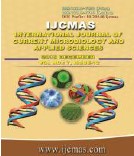


 National Academy of Agricultural Sciences (NAAS)
National Academy of Agricultural Sciences (NAAS)

|
PRINT ISSN : 2319-7692
Online ISSN : 2319-7706 Issues : 12 per year Publisher : Excellent Publishers Email : editorijcmas@gmail.com / submit@ijcmas.com Editor-in-chief: Dr.M.Prakash Index Copernicus ICV 2018: 95.39 NAAS RATING 2020: 5.38 |
A field trial was conducted to study the climate change effects on quality makhana production at ICAR-RCER, Research Centre on Makhana during 2016-2017. The objectives of the study were developing new makhana production strategies to secure sustainable production under climate change or various weather conditions. High temperature and reduced humidity resulted in production of rather smaller nuts and leaves. The results revealed that makhana is a photo insensitive crop and its growth and development are markedly changed with the change of climates. Fruit number, seed numbers/fruits and yield were gradually increased from February to till September. Winter climate restricted commercial production of makhana for October transplanted crop. However, November and December planted makhana produced yield similar to January crop after recovering unfavourable weather of winter. The maximum numbers of fruit (15.33) and yield (62.0Q/ha) were observed in September planted crop. The gestation period of this crop was minimum (110 days) in February planted crop as compared to October (152 days). Winter makhana, which was planted in July showed highest nut quality in terms of protein (11.35 %) content. Plant grown in extreme winter and summer showed decreased in protein content. As far as pest infestation is concerned, the aphid (Rhopalosiphum nymphaeae) is found infesting Makhana crop at nursery stage in winter. However, no economic damage was observed. During this study, the maximum temperature was 430 C in May (2016) and the minimum temperature was 50C in January (2017). Hence, high and low temperature resulted in reduction in growth parameters (nut and leaf), while moderate temperature enhances protein production and yield.
 |
 |
 |
 |
 |